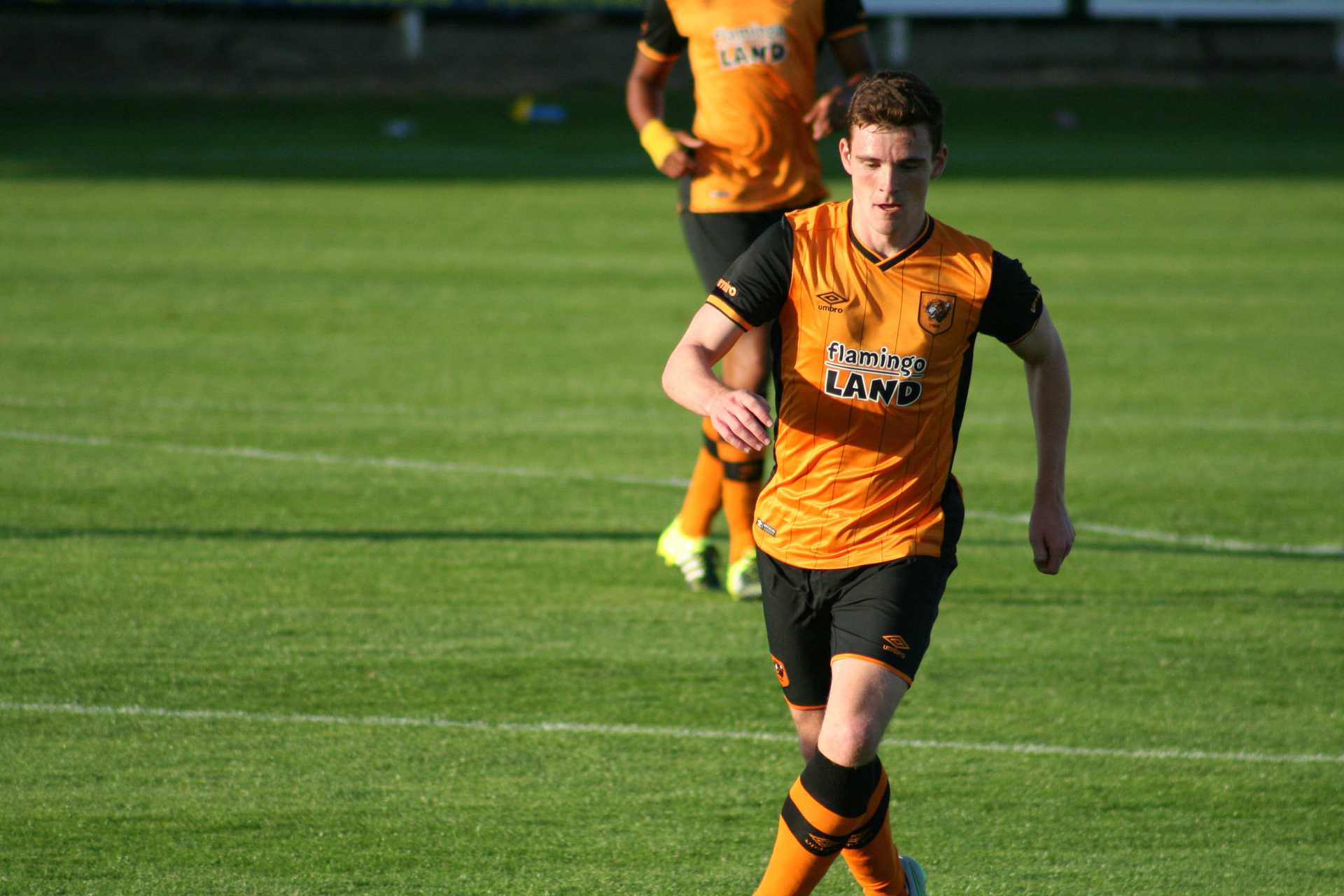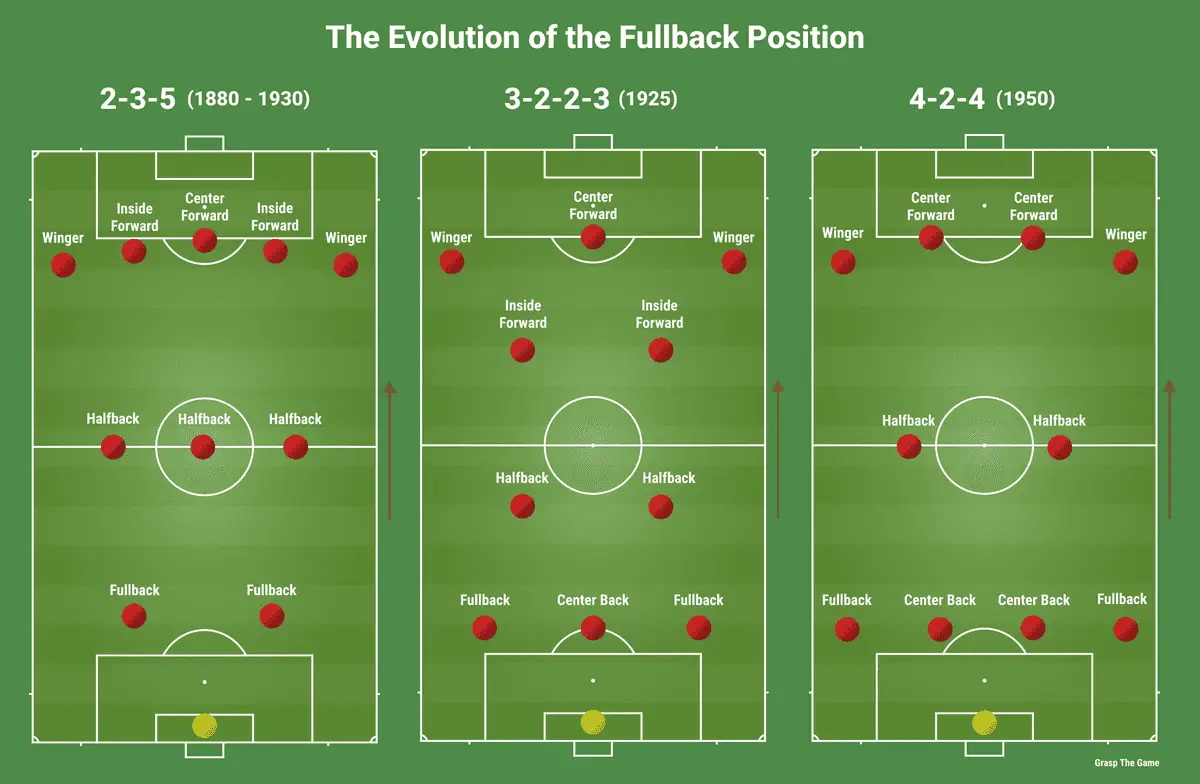What Is a Fullback in Soccer?

A fullback in soccer is primarily a defensive player that is positioned on the sides (flanks) of the field. Their main job is to prevent the opposition from delivering dangerous passes into the center of the field. They do this by attempting to make tackles against the opposition's wide players.
The fullback position is normally found when the team is playing in a formation with four defenders. In these formations, the team will have two fullbacks that are positioned outside of two center backs. These are known as the Left-back and the Right-back.
What are the main responsibilities of the fullback?
Historically, a fullback was a very defensive position and was considered very unglamorous. It was often joked that children never had ambitions to play as a fullback when they were older, and it was quite common in amateur and street soccer for the worst player in the team to be forced to play as a fullback, as they will see very little of the ball if they do not have the abilities to excel in the role.
"No one wants to grow up and be a Gary Neville"
In modern soccer, things have changed dramatically. The fullback is a key position that can have a massive influence on how the team plays. The role is still primarily a defensive role, however, the fullback must also be able to supplement their defensive duties with attacking runs down the wing to support the attackers in the opponent's half of the field.
It is common for a fullback to excel at either the defensive or the attacking aspect of the game, but it is quite rare to find an elite fullback that has mastered both.
The playing style of the team's manager will dictate how attacking the fullbacks will play, with some preferring their fullbacks to focus more on defense, and others preferring their fullbacks to play more as wingers.
No-nonsense fullback
The no-nonsense fullback is a defensive-minded fullback, that will very rarely take risks in going forward. They will hold their defensive position and make simple passes down the flanks of the field or into the central midfielders.
Any crosses that are attempted will be made from a deep position, and they will very rarely dribble with the ball. They will keep things as simple as possible with the aim of defending and retaining possession by passing the ball to their more attack-minded teammates.
Attacking fullback
The attacking fullback will spend almost as much time attacking as they do defending. They will be positioned in a much more advanced role and be more comfortable in dribbling the ball and playing more difficult passes to their teammates.
They will attempt to overlap the midfield players and get to the opposition byline, where they will put crosses into the opponent's penalty area.
It is important that the attacking fullback does not lose possession of the ball, as their advanced position leaves a big space behind them that the opposing team can take advantage of in the event of a counter-attack.
Inverted fullback
The inverted fullback will have the same duties as a standard fullback, however, instead of limiting their play to the flanks of the field, they will occasionally drift into a more central position and play more like a center back or defensive central midfield player. This is usually done when their teammate on the opposite side of the field is in an advanced position.
This strategy is often associated with Pep Guardiola, but Johan Cruyff was using a similar strategy with his Barcelona team a long time before (a team which Guardiola was playing for).
Notable examples of players that have played as an inverted fullback include Philipp Lahm and David Alaba at Bayern Munich, and Kyle Walker and João Cancelo at Manchester City.
What attributes do you need to be a fullback?
Physical attributes
Studies have shown that fullbacks cover some of the greatest distances during a game, second only to central midfielders. It is also a fact that the fullbacks will perform more high-intensity sprints than players positioned in the center of the field. For this reason, fullbacks must have excellent fitness levels to perform their roles. They must be able to sprint forwards to assist in the team's attacking phases, but then they must also be able to sprint back to perform their defensive duties when possession has been lost. The elite fullback will have lots of pace and acceleration, and also good agility to allow for rapid changes in direction.
Mental attributes
A top-class fullback must be able to read the game well. Due to the constant switching between defensive and attacking roles, it is essential for them to be able to anticipate opposition danger, as well as attacking opportunities and position themselves accordingly. If a fullback is too focused on their attacking duties and is not able to anticipate any danger behind them, they will become a liability to the team.
Technical attributes
As we have already established, the primary role of a fullback is to defend, so it is logical that a good fullback must be able to mark their opposition players and tackle them when necessary. They must also have a good heading ability, although this is not as important as it is for the position of center back. For the attacking fullback, good passing, crossing, and dribbling abilities are required.
The evolution of the fullback position
Soccer formations and positions have evolved a huge amount since the game was first invented in the 19th century. In the 1890s, the most popular tactical formation was the 2-3-5, or the "Pyramid". The players in this formation were grouped into three categories, based on how far up the field they played. These categories were the Forwards, Halfbacks, and Fullbacks. The fullbacks were the players in the most defensive positions and therefore were "fully back".
In 1925, there was a change in the offside rule, which prompted most teams to change from a 2-3-5 to a 3-2-2-3 formation, also known as the "WM" formation. This formation involved the introduction of a center back to stop the opposing center forward, and meant that the remaining fullbacks played a little wider than previously.
It wasn't until the 1950s that fullbacks began to play in the positions that we are accustomed to today. The 4-2-4 formation was perfected by the Brazilian teams of the late 1950s and involved the use of two center backs and two fullbacks.

Who are the greatest fullbacks of all time?
It is very difficult to say who are the best fullbacks of all time, as it is very much a matter of personal opinion. Some people prefer a solid, dependable fullback that is only focused on their defensive responsibilities, while others prefer a fullback that excels in attacking, creating assists for their teammates and scoring goals.
With that being said, here are some of the most popular fullback to have ever played the game.
Ashley Cole
Ashley Cole played as a left-back for Arsenal, Chelsea, and England. For a period of his career, he was considered by many to be the best left-back in the world. He made 107 appearances for England, making him the country's most-capped fullback. Cole has played in many memorable games, but perhaps his most famous are the games where he played against Cristiano Ronaldo and was seen to dominate the Portuguese forward.
Dani Alves
Daniel Alves is the most decorated soccer player in the history of the game, winning a total of 47 titles. The right-back has won the Champions League 3 times, La Liga 6 times, Ligue 1 twice, Serie A once, and the Europa League twice. Alves was never really known for a strong defensive game but excelled in his attacking play, most notably for one of the greatest ever Barcelona teams, where he made over 400 appearances and provided over 100 assists.
Paulo Maldini
Maldini was a one-club man, playing for AC Milan for his entire career, making an incredible total of 902 appearances. He was comfortable playing in both the center back and fullback positions and was famous for his ability to read the game.
Philipp Lahm
Philipp Lahm was captain of Bayern Munich, playing 332 games for the club. He was also the captain of his national team, earning 113 caps, including during the World Cup of 2014, in which Germany were crowned champions. Lahm was included in the World Cup team of the tournament 3 times, and the UEFA Team of the Tournament twice and in the UEFA Team of the Year 5 times.
Roberto Carlos
Roberto Carlos was once described as the "most offensive-minded left-back in the history of the game". Famous for his powerful shots and free-kicks, he managed to score 80 goals in his career, playing over 600 games, most notably for Real Madrid and Brazil.
Modern challenges
The fullback position in modern soccer has become very demanding. One of the main challenges is that fullbacks are now expected to not only defend but also help out with attacking. This means they need to be good at dribbling, passing, and crossing the ball.
Another challenge is the increased physical demands of the position. Today's soccer is played at a fast pace and fullbacks need to have the stamina and strength to keep up with the play for the whole match.
Fullbacks also have to be able to think and make decisions quickly. Different teams use different ways of playing and fullbacks need to be able to adjust to these different strategies.
The tactics used to utilize fullbacks
- Overlapping Runs: This tactic involves the fullback making a run up the field to overlap the winger, providing an extra attacking option and creating space for the winger to exploit.
- Inverted Fullback: This tactic involves using a fullback as a central midfielder, which allows the team to maintain a balance between defense and attack, and it can also create an extra passing option in midfield.
- Crossing: Fullbacks are often used to deliver crosses into the box from wide positions, creating scoring opportunities for the team's forwards.
- Pressing: Fullbacks can be used as part of a team's pressing strategy, helping to press the opposing team's defense and midfield, and recovering the ball quickly.
- Counter-attacks: Fullbacks can be used to initiate counter-attacks by making quick and accurate passes to the midfielders and forwards.
FAQs
Is fullback a hard position?
The modern fullback position in soccer can be very hard to master. Fullbacks are expected to contribute to both the attack and defense, and require players to have good technical skills such as dribbling, passing, and crossing, and also physical attributes such as stamina and endurance to cover a lot of ground.
Are fullbacks fast?
Not all fullbacks are fast, but it is definitely an advantage if a fullback has a good amount of pace so they are able to keep up with the opposition wingers. Some fullbacks can make up for a lack of pace by having great anticipation and being able to read the game well.
Do fullbacks run the most?
Fullbacks can run some of the greatest distances during a game when compared to other positions. An attacking fullback must be able to contribute in both halves of the soccer field, so they must consistently run up and down the field for the duration of the game.
Are fullbacks tall?
Some of the greatest soccer fullbacks were relatively short when compared to other positions. Dani Alves: 172cm, Roberto Carlos: 168cm, Philipp Lahm: 170cm, Marcelo: 174cm.
Credit: Featured photo of Andy Robertson | flickr photo by dom fellowes shared under a Creative Commons (BY) license